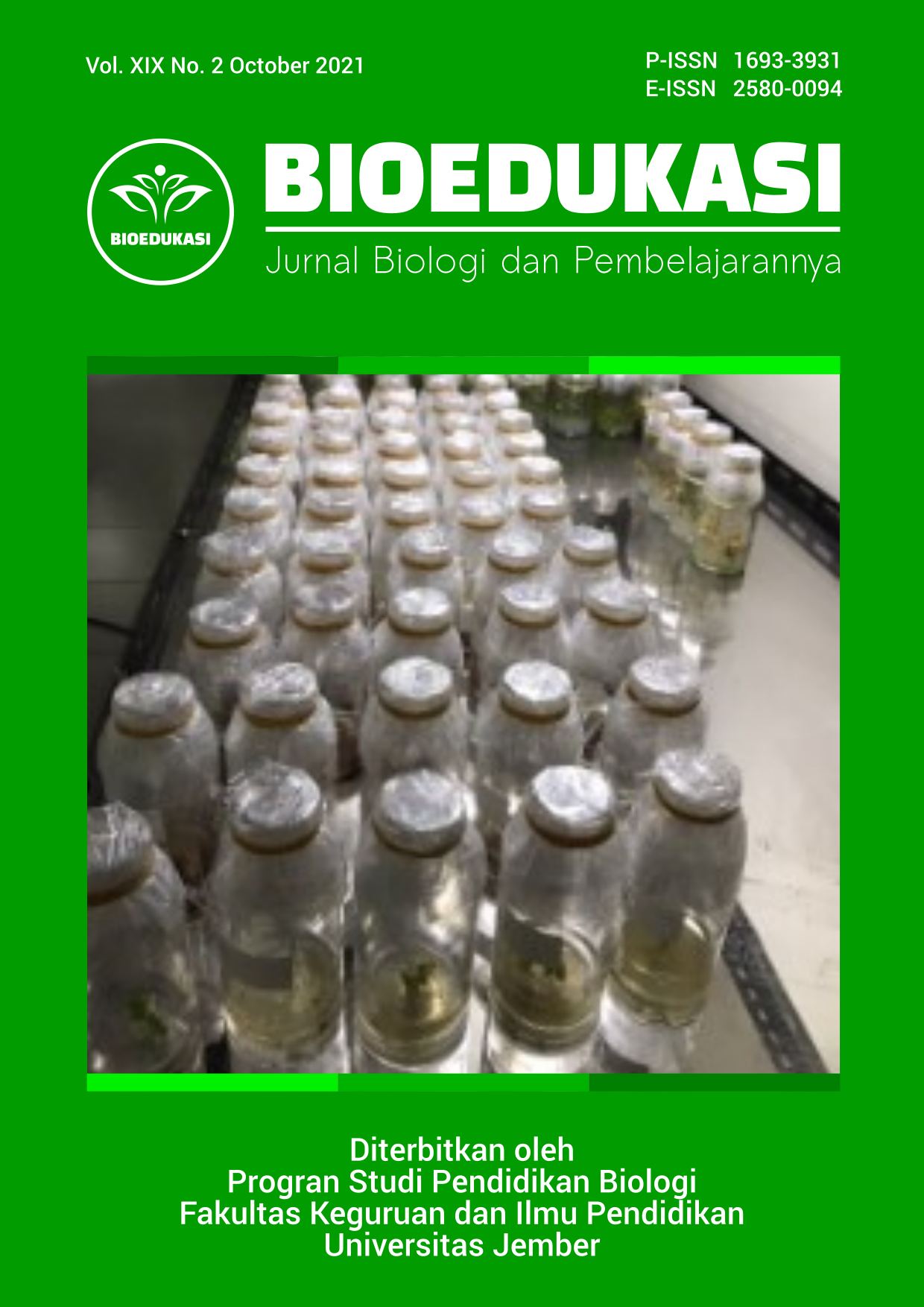ANOPHELES MICROBIOTA IN MALARIA VECTOR AND THE EFFECT ON PARASITE TRANSMISSION
DOI:
https://doi.org/10.19184/bioedu.v19i2.25165Keywords:
Microbiota, Anopheles, PlasmodiumAbstract
Malaria is a vector-transmitted disease with a high number of cases. Plasmodium parasites are transmitted from the body of the Anopheles mosquito to the host through several mosquito organs, including the salivary glands and the midgut. The salivary glands and the midgut, apart from being a breeding ground for parasites, are known from several studies that various types of microbiota inhabit these two organs. The group of bacteria is the most widely known to be associated with Anopheles mosquitoes. The bacteria found were dominated by Gram-negative bacteria, with Pseudomonas being the most common, followed by Aeromonas, Asaia, Comamonas, Elizabethkingia, Enterobacter, Klebsiella, Pantoea, and Serratia. The group of Gram-positive bacteria was represented by the genera Bacillus, Streptococcus, Lactobacillus, and Staphylococcus. Each species of Anopheles has a different composition of associated bacteria. Anopheles-associated bacteria currently receive much attention because of their role in fighting Plasmodium infection. The ability of malaria vector-associated bacteria to inhibit and fight Plasmodium infection is divided into three mechanisms. Bacteria can triger an immune response through the Immune-deficiency (IMD) pathway, which causes active anti-Plasmodium and the production of antimicrobial peptides, increasing ROS synthesis and microbiota, which trigger hemocyte differentiation to protect against Plasmodium. This function related to inhibiting Plasmodium development needs further research so that later it can become an option for vector-based malaria control without damaging the sustainability of the environment.
Downloads
References
Bahia, A.C., J. H. M. Oliveira., M. S. Kubota., H. R. J. Araujo., J. B. P. Lima., C. M. Rios-Velasquez., M. V. G. Lacerda., P. L. Oliveira., Y. M. Traub-Cseko., and P. F. P. Pimenta. 2013. The role of reactive oxygen species in Anopheles aquasalis response to Plasmodium vivax infection. PloS one 8, e57014
Bai, L., L. Wang, J. Vega-RodrÃguez, G. Wang and S. Wang. 2019. A Gut Symbiotic Bacterium Serratia marcescens Renders Mosquito Resistance to Plasmodium Infection Through Activation of Mosquito Immune Responses. Frontiers Microbiology. Vol 10.
Bates, A. 1990. The Natural History of Mosquitoes and Plasmodium Parasites. New York.: Gloucester. Mass. Peter Smith
Belachew, E. B. 2018. Immune response and evasion mechanisms of Plasmodium falciparum parasites. Journal of immunology research.
Berhanu, A., A. Abera, D. Nega, S. Mekasha, S. Fentaw, A. Assefa, G. Gebrewolde, Y. Wuletaw, A. Assefa, S. Dugassa, H. Tekie and G. Tasew. 2019. Isolation and identification of microflora from the midgut and salivary glands of Anopheles species in malaria endemic areas of Ethiopia. BMC Microbiology, 19:85.
Chavshin, A. R., M. A. Oshaghi, H. Vatandoost., M. R. Pourmand., A. Raeisi and O. Terenius. 2014. Isolation and Identification of Culturable Bacteria from Wild Anopheles culicifacies, A First Step in A Paratransgenesis Approach. Parasit Vectors; 7: 419.
Cirimotich, C. M., Y. Dong, A. M. Clayton, S. L. Sandiford, J.A. Souza-Neto, M. Mulenga, and G. Dimopoulos. 2011. Natural microbe mediated refractoriness to Plasmodium infection in Anopheles gambiae. Science. 332 (6031): 855 - 8.
Clayton, A. M., Dong, Y., dan Dimopoulos, G. 2014. The Anopheles innate immune system in the defense against malaria infection. Journal of innate immunity. 6(2): 169-181.
Dedkhad, W., L. C. Bartholoma., B. M. Christensen., C. Hempolchom., U. Chaithong., dan A. Saeung. 2019. Hemocyte classification of three mosquito vectors: Aedes togoi, Anopheles lesteri and Culex quinquefasciatus. Tropical Biomedicine. 36(2): 505-513.
Dong, Y., F. Manfredini., and G. Dimopoulos. 2009. Implication of The Mosquito Midgut Microbiota in The Defense Against Malaria Parasites. PLoS Pathog ;5(5): e1000423.
Favia, G., I. Ricci, C. Damiani, N. Raddadi, E. Crotti, M. Marzorati, A. Rizzi, R. Urso, L. Brusetti, S. Borin, D. Mora, P. Scuppa, L. Pasqualini, E. Clementi, M. Genchi, S. Corona, I. Negri, G. Grandi, A. Alma, L. Kramer, F. Esposito, C. Bandi, L. Sacchi, and D. Daffonchio. 2007. Bacteria of the genus Asaia stably associate with Anopheles stephensi, an Asian malarial mosquito vector. Proc Natl Acad Sci USA 104:9047–9051
Fitriany, J., dan S. Ahmad. 2018. Malaria. Jurnal averrous. (4) 2.
Gao, H., C. Cui, L. Wang, M. Jacobs-Lorena, and S. Wang. 2020. Mosquito microbiota and implications for disease control. Trends in parasitology. 36(2): 98-111.
Gendrin, M., and G. K. Christophides. 2013. The Anopheles Mosquito Microbiota and Their Impact on Pathogen Transmission. Intech. Chapter 17.
Gonzalez-Ceron, L., F. Santillan., M. H. Rodriguez., D. Mendez., and J. E. Hernandez-Avila. 2003. Bacterial in midguts of field-collected Anopheles albimanus block Plasmodium vivax sporogonic development. J Med Entomol.40(3):371–4.
Guégan, M., K. Zouache, C. Démichel, G. Minard., V. T. Van., P. Potier., P. Mavingui., and C. V. Moro. 2018. The mosquito holobiont: fresh insight into mosquito-microbiota interactions. Microbiome. 6:49
Hakim, L. 2011. Malaria: Epidemiologi Dan Diagnosis. Aspirator Journal of Vector Borne Diseases, 3(2): 53932.
Harbach, R.E. 2013. The phylogeny and classification of Anopheles. In: S. Manguin (ed.). Anopheles Mosquitoes - New Insights into Malaria Vectors. InTech Open Access Publisher, Rijeka, Croatia. http://dx.doi.org:10.5772/56117
Hillyer, J. F. 2010. Mosquito immunity. Invertebrate Immunity. 218-238.
Kajla, M. K., O. Andreeva, T. M. Gilbreath, S. M. Paskewitz. 2010. Characterization of expression, activity and role in antibacterial immunity of Anopheles gambiae lysozyme c-1. Comparative biochemistry and physiology Part B, Biochemistry & molecular biology. 155(2): 201-9
Kalappa, D. M., P. A. Subramani, S. K. Basavanna, S. K. Ghosh, V. Sundaramurthy, S. Uragayala, S. Tiwari, A. R. Anvikar, and N. Valecha. 2018. Influence of midgut microbiota in Anopheles stephensi on Plasmodium berghei infections. Malar J 17, 385.
Kambris, Z., P. E. Cook, H. K. Phuc and S. P. Sinkins. 2009. Immune activation by life shortening Wolbachia and reduced filarial competence in mosquitoes. Science. 326 (5949): 134-6.
Kampfer, P., H. Matthew, S. P. Glaeser, K. Martin, N. Lodders, and I. Faye. 2011. Elizabethkingia Anophelis sp. nov., isolated from the midgut of the mosquito Anopheles gambiae. Int J Syst Evol Microbiol. 61(Pt 11):2670-5.
Kementrian Kesehatan Republik Indonesia. 2019. Laporan Situasi Terkini Perkembangan Program Pengendalian Malaria Di Indonesia Tahun 2019. Jakarta: Direktorat Jenderal Pencegahan Dan Pengendalian Penyakit
Kumar, S., A. Molina-Cruz, L. Gupta, J. Rodrigues, and C. Barillas-Mury. 2010. A peroxidase/dual oxidase system modulates midgut epithelial immunity in Anopheles gambiae. Science. 327(5973):1644-8.
Kumar, A., P. Srivastava., N. N. D. P. Sirisena., S. K. Dubey., R. Kumar., J. Shrinet., and S. Sunil. 2018. Mosquito innate immunity. Insects. 9(3): 95.
Lindh, J. M., O. Terenius, and I. Faye. 2005. 16S rRNA gene-based identification of midgut bacteria from field-caught Anopheles gambiae sensu lato and A. funestus mosquitoes reveals new species related to known insect symbionts. Applied and environmental microbiology. 71 (11):7217-23.
Manguin, S., C. T. Ngo, K. Tainchum, W. Juntarajumnong, T. Chareonviriyaphap, A. L. Michon, and E. J. Bilak. 2013. Bacterial biodiversity in midguts of Anopheles mosquitoes, malaria vectors in Southeast Asia in Anopheles Mosquitoes - New Insights into Malaria Vectors. InTechOpen Access, 549–576.
Meibalan, E., dan M. Marti. 2017. Biology of Malaria Transmission. Cold Spring Harb Perspect Med. 7(3): a025452.
Meister, S., B. Agianian, F. Turlure, A. Relogio, I. Molrais, F. C. Kafatos, and G. K. Christopides. 2009. Anopheles gambiae PGRPLC-mediated defense against bacteria modulates infections with malaria parasites. PLoS pathogens. 5(8).
Minard, G., F. H. Tran, V. T. Van, C. Goubert, C. Bellet, K. Lambert, K. L. H. Kim, T.H.T. Thuy, P. Mavingui and C. Valiente Moro. 2015. French Invasive Asian Tiger Mosquito Populations Harbor Reduced Bacterial Microbiota and Genetic Diversity Compared to Vietnamese Autochthonous Relatives. Front. Microbiol 6:970.
Ngo, C. T., S. Romano, S. Manguin, and E. J. Bilas. 2016. Diversity of the Bacterial Microbiota of Anopheles Mosquitoes from Binh Phuoc Province, Vietnam. Frontiers in Microbiology. Vol 7.
Ngwa, C. J., V. Glöckner., U. R. Abdelmohsen, M. Scheuermayer., R. Fischer, U. Hentschel, and G. Pradel. 2013. 16SrRNA gene-based identification of Elizabethkingia meningoseptica (Flavobacteriales: Flavobacteriaceae) as a dominant midgut bacterium of the Asian malaria vector Anopheles stephensi (Dipteria: Culicidae) with antimicrobial activities. J Med Entomol 50: 404–412.
Noden, B. H., J. A. Vaughan, C. B. Pumpuni, and J. C. Beier. 2011. Mosquito ingestion of antibodies against mosquito midgut microbiota improves conversion of ookinetes to oocysts for Plasmodium falciparum, but not P. yoelii. Parasitology international; 60(4): 440-6.
Osei-Poku, J., C. Mbogo, W. Palmer, F. Jiggins. 2012. Deep sequencing reveals extensive variation in the gut microbiota of wild mosquitoes from Kenya. Mole Ecolo; 21: 5138–5150
Pimenta, P.F., A. S. Orfano, A. C. Bahia, P. Sharma, J. Rani, C. Chauhan, S. Kumari, S. Tevatiya, T. D. De, D. Savargaonkar, K. C. Pandey and R. Dixit. 2015. An overview of malaria transmission from the perspective of Amazon Anopheles vectors. Mem Inst Oswaldo Cruz, Rio de Janeiro, Vol. 110(1).
Pumpuni, C. B., M. S. Beier., J. P. Nataro., L. D. Guers., and J. R. Davis. 1993. Plasmodium falciparum: inhibition of sporogonic development in Anopheles stephensi by gram negative bacteria. Experimental parasitology. 77(2):195-9.
Rani, A., A. Sharma., R. Rajagopal., T. Adak., and R. K. Bhatnagar. 2009. Bacterial diversity analysis of larvae and adult midgut microflora using culture dependent and culture independent methods in lab-reared and field collected Anopheles stephensian Asian malarial vector. BMC Microbiol. 9:96.
Schneider, P., T. Bousema, S. Omar, L. Gouagna, P. Sawa, H. Schallig, and R. Sauerwein. 2006. microscopic Plasmodium falciparum gametocytaemia in Kenyan children after treatment with sulphadoxine-pyrimethamine monotherapy or in combination with artesunate. International journal for parasitology; 36:403–408
Scolari, F., M. Casiraghi., and M. Bonizzoni. 2019. Aedes spp. and Their Microbiota: A Review. Front. Microbiol.
Sharma, P., S. Sharma, R. K. Maurya, T. D. De, T. Thomas, S. Lata, N. Singh, K. C. Pandey, N. Valecha, and R. Dixit. 2014. Salivary glands harbor more diverse microbial communities than gut in Anopheles culicifacies. Parasites & Vectors. 7:235
Thongsripong, P., J.A. Chandler, A.B. Green, P. Kittayapong, B. A. Wilcox, D. D. Kapan and S. N. Bennett. 2017. Mosquito vector associated microbiota: Metabarcoding bacteria and eukaryotic symbionts across habitat types in Thailand endemic for dengue and other arthropod borne diseases. Ecol. Evol. 8, 1352–1368
Wang, S., A. K. Ghosh., N. Bongio., K. A. Stebbings., D. J. Lampe., and M. JacobsLorena. 2012. Fighting malaria with engineered symbiotic bacteria from vector mosquitoes. Proc. Natl. Acad. Sci. U.S.A. 109, 12734–12739.
WHO (World Health Organization). 2007. Anopheline Species Complexes in South and South-East Asia. India
WHO (World Health Organization). 2015. Global Technical Strategy for Malaria 2016–2030. United Kingdom.
WHO (World Health Organization). 2015. Key Fact Malaria. https://www.who.int/news-room/fact-sheets/detail/malaria
Wilke, A. B and M. T. Marrelli. 2015. Paratransgenesis: a promising new strategy for mosquito vector control. Parasit. Vector 8, 342.
Yilmaz, B., S. Portugal, T. M. Tran, R. Gozzelino, S. Ramos, J. Gomes, A. Regalado, P. J. Cowan, A. J. F. d’Apice, A. S. Chong, O. K. Doumbo, B. Traore, P. D. Crompton, H. Silveira, and M. P. Soares. 2014. Gut Microbiota Elicits a Protective Immune Response against Malaria Transmission. Cell: 159, 1277–1289
Zakovic, S., dan E. A. Levashina. 2017. NF-κB-like signaling pathway REL2 in immune defenses of the malaria vector Anopheles gambiae. Frontiers in cellular and infection microbiology. 7: 258.






